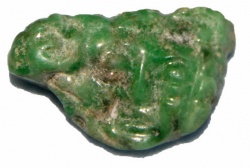The Mythology of Jade
by Sarah Todd
Although predominantly associated with the Far East, jade was generally regarded as a lucky or protective gemstone in many ancient cultures. Man has been working with and using jade for over 7,000 years. In prehistoric times jade’s strength made it a natural choice for crafting tools and weapons. The Ancient Egyptians revered jade as the stone of balance, harmony, love and inner peace. The Central American Aztec, Mayan and Olmec peoples held jade in even higher esteem than gold. The Maoris of New Zealand began carving weapons and cult artefacts from jade many centuries ago, a tradition that continues today.
Jade in Ancient China
References dating back to 3,000 BC state that the Chinese people referred to jade as “vu”, meaning “royal gem”. Jade has been revered throughout China’s long cultural history, used to craft the best artefacts and figurines. Jade was used to furnish the imperial family’s tombs. Chinese culture regards jade as representative of the Confucian values of compassion, courage, justice, modesty and wisdom.
One legend claims that when the Mongols invaded China, the dragons wept for the Chinese people. When their tears reached Earth, they changed to jade. After jade was first discovered in the Black Jade and White Jade rivers women rather than men would gather the gemstones. Jade is considered a Yang or masculine force, meaning the gemstones would be attracted to the feminine Yin force and so be easier to collect.
During the 18th century Chinese Emperor Qianlong satisfied his obsession with jade by collecting a vast amount of the gemstone. This collection was looted by different invading nations and individuals – from the French and British crusades in China to the Japanese invasion and Chairman Mao. By the late 19th century jade had become popular with collectors from all over the world. Alfred Nobel and J P Morgan were among some of the gemstone’s most distinguished admirers.
The Modern Value of Jade
In 1999 a jade bracelet was auctioned by Christie’s in Hong Kong for the remarkable price of $2.5 million – a record for the quality and size of jade. A 77 carat cabochon ring was sold for US$2.4 million.
In 1997 Christie’s in London sold a jadeite necklace for $10 million. The sale caught the attention of investigative reporters Adrian Levy and Cathy Scott-Clark, who went to Myanmar to investigate that country’s jade mining industry. Their shocking discoveries are detailed in the acclaimed book “The Stone of Heaven”, and prove the link between politics, power and oppressive leaders is not restricted to diamonds.
The Healing Power of Jade
The name “jade” is derived from the Spanish term “piedra de ijada”, meaning “loin stone”. It is claimed jade is an effective treatment against kidney disease. The Greek name for nephrite jade is “lapis nephriticus”, which means “kidney stone. Jade is said to benefit the immune system, cleanse the blood and soothe the nervous system.
A legend claiming Buddha’s tears are pure jade may be behind the theory that jade can treat eye disorders. Healers say the gemstone also benefits the hips, heart, spleen and thymus gland as well as aid poor digestion, relieve constipation and promote healthy hair. Jade should be worn so it rests on the skin over the troubled part of the body.
Jade is considered a gemstone of good fortune, bringing its wearer or owner wealth, stability and love. Lovers exchange jade gifts to confirm their love and devotion to each other. Jade helps open the heart chakra while attracting love, enhancing sexuality and fertility. It is also a protective stone, guarding against misfortunes and accidents.
Jade is associated with the planets Jupiter and Pluto, and is the zodiac stone for Aries, Taurus, Gemini, Libra and Pisces. It is the birthstone for May and the gemstone commemorating the 12th wedding anniversary.
The Colours of Jade
According to gemstone therapy jade "stimulates creativity and mental agility on the one hand, while also having a balancing and harmonizing effect”. Green jade is calming when held. Lavender jade helps ease emotional and mental problems because it radiates love, beauty and security. Blue jade encourages the mind’s thought processes and imagination, and mauve jade’s gentle vibration helps the wearer’s spiritual needs.
Orange jade gives its wearer energy. Red jade vibrates at a higher energy level, helping bring anger to the surface so the wearer can deal with it and move on to more positive occupations.
